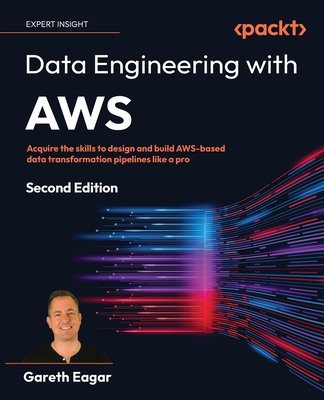
Eagar, Gareth
- Delve into robust AWS tools for ingesting, transforming, and consuming data, and for orchestrating pipelines
- Stay up to date with a comprehensive revised chapter on Data Governance
- Build modern data platforms with a new section covering transactional data lakes and data mesh
This book, authored by a seasoned Senior Data Architect with 25 years of experience, aims to help you achieve proficiency in using the AWS ecosystem for data engineering. This revised edition provides updates in every chapter to cover the latest AWS services and features, takes a refreshed look at data governance, and includes a brand-new section on building modern data platforms which covers; implementing a data mesh approach, open-table formats (such as Apache Iceberg), and using DataOps for automation and observability.
You'll begin by reviewing the key concepts and essential AWS tools in a data engineer's toolkit and getting acquainted with modern data management approaches. You'll then architect a data pipeline, review raw data sources, transform the data, and learn how that transformed data is used by various data consumers. You'll learn how to ensure strong data governance, and about populating data marts and data warehouses along with how a data lakehouse fits into the picture. After that, you'll be introduced to AWS tools for analyzing data, including those for ad-hoc SQL queries and creating visualizations. Then, you'll explore how the power of machine learning and artificial intelligence can be used to draw new insights from data. In the final chapters, you'll discover transactional data lakes, data meshes, and how to build a cutting-edge data platform on AWS.
By the end of this AWS book, you'll be able to execute data engineering tasks and implement a data pipeline on AWS like a pro!
What you will learn- Seamlessly ingest streaming data with Amazon Kinesis Data Firehose
- Optimize, denormalize, and join datasets with AWS Glue Studio
- Use Amazon S3 events to trigger a Lambda process to transform a file
- Load data into a Redshift data warehouse and run queries with ease
- Visualize and explore data using Amazon QuickSight
- Extract sentiment data from a dataset using Amazon Comprehend
- Build transactional data lakes using Apache Iceberg with Amazon Athena
- Learn how a data mesh approach can be implemented on AWS
This book is for data engineers, data analysts, and data architects who are new to AWS and looking to extend their skills to the AWS cloud. Anyone new to data engineering who wants to learn about the foundational concepts, while gaining practical experience with common data engineering services on AWS, will also find this book useful. A basic understanding of big data-related topics and Python coding will help you get the most out of this book, but it's not a prerequisite. Familiarity with the AWS console and core services will also help you follow along.
Table of Contents- An Introduction to Data Engineering
- Data Management Architectures for Analytics
- The AWS Data Engineer's Toolkit
- Data Governance, Security, and Cataloging
- Architecting Data Engineering Pipelines
- Ingesting Batch and Streaming Data
- Transforming Data to Optimize for Analytics
- Identifying and Enabling Data Consumers
- A Deeper Dive into Data Marts and Amazon Redshift
- Orchestrating the Data Pipeline
(N.B. Please use the Look Inside option to see further chapters)
member goods
listens & views

PERGOLESI: STABAT MATER / SALVE ...
by PERGOLESI / LESNE / CLEMENCIC CONSORT / CLEMENCIC
COMPACT DISCout of stock
$8.49






